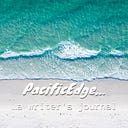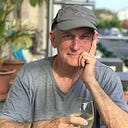Reviews…
In Tasmania
It is not a new book but it is a worthwhile one. Nicholas Shakespeare’s story is one for all tasmaniaphiles and others interested in this southern outlier of the Australian landmass. This story was originally published in 2008.
CAR’S HEADLIGHTS have been turned on and clusters of commuters, hands thrust deep into pockets and heads bowed, scurry homeward from the ferry wharf. On this cold Friday in winter the day is drawing to a close and a chilling wind blows in from the sea… it is the kind of evening when you turn your collar up and hurry to wherever it is that you are going. It is an evening for staying inside.
Impulse is what drives me into Desire Books and Records as if invited by the pool of warm yellow light spilling from the shop onto the cold footpath. Desire is an intriguing secondhand bookstore in an old Art Deco building set a little distance off The Corso, Manly’s main thoroughfare. The bookshop made up the quartet of my favourite shops in Manly at the time, along with Candies coffee lounge — Candie is an American refugee who escaped to Australia decades ago; she later sold the cafe but the name remains — Manly Food Coop and Heritage surf shop. Heritage’s owner set up the business after retiring from the music industry. He explained to me that he intended the shop to be an independent and authentic surf shop like those of the 1960s , the time of surfing’s birth as a subculture and popular sport, rather than like one of the chain of brand-name corporate surf shops, Mambo and Rip Curl and the like over on The Corso. Sadly, Heritage is no more. It is now a Patagonia shopfront.
I had been looking for a copy of Jack Kerouac’s Visions of Cody. Desire had many of his other works along with Burroughs, Snyder, Ginsberg and the rest of the Beats, but not the volume I sought. The Beats have their own special shelf at Desire. In the shop you also notice the turntable on which the staff play jazz LPs, products of the age when music was recorded as a continuous groove stamped into platters of flattened vinyl.
I look around and glimpse a copy of Nicholas Shakespear’s 2004 book, In Tasmania. I noticed it when it was first released and although it looked intriguing I resisted buying it. Now, here it was and at a good secondhand price. I buy it. I never regret doing so.
Shakespear’s is one of those books that are hard to put down. Although a work on nonfiction, he has written it like a detective novel in which he traces people and figures historic and contemporary by linking clues until he reaches a point of revelation. He does this with the actor Merle Oberon, who turns out not to have been a Tasmanian despite her claims of being so. The 1930s actor, Errol Flynn, we know was an authentic Tasmanian.
An island in time
But first, the island.
When I lived here in the 1970s I learned that this was no ordinary place. I spent a lot of time in the backcountry, mainly in the mountains that make up the elevated centre of this triangular landmass that fronts the swells of the Southern Ocean and is swept by the winds named by Nineteenth Century mariners as the Roaring 40s. It was there I learned of the ‘otherness’ of the island and came to understand that Tasmania really is a land apart. This, Shakespeare and alludes to when he writes that Tasmania is:
“…an island with an intensity of light but with dark patches deliberately concealed and not talked about”
…and when he claims that:
“…something… gives the impression it was an outpost”.
David Holmgren, co-originator of the permaculture design system, a Tasmanian invention, suggested this otherness when he described the island as “a place where modernity and nature collide, both destructively and creatively”. Shakespeare quotes Tasmanian historian, Cassandra Pybus, saying:
“In Tasmania we tell stories to reassure ourselves we have not slipped unnoticed over the rim of the world”.
Shakespeare hints at Tasmania’s difference in his discussion with two aged, unmarried sisters who lived in an old timber house in the island’s north-west. The sisters were small farmers, growing potatoes and vegetables and rearing livestock. They had never travelled further than Launceston, little more than 90km to the east. Their produce was not sold. It was bartered with a business in the nearby town of Ulverstone. They exchanged their potatoes, bags of onions, eggs and and other produce for wire, groceries and their other modest utilitarian needs.
Reading Shakespeare’s book takes you into territory that is almost preindustrial in feel, territory that is, perhaps, just a little disquieting as if it is from some lost age, which it might now be.
Beyond Ulverstone
Swansea is a town favourably situated across the bay from The Hazards, a low range of bare, pink granite peaks that make up the northern end of Freycinet National Park.
I recall Swansea as a stopover during a solo bicycle tour up the island’s east coast, and The Hazards as a climb to get to Wineglass Bay on the other side, a place where dolphins came into the shallow water only a couple metres from the beach where their dark eyes looked at we humans as we looked at them and wondered what ideas they formed of us.
Swansea is one of those towns the tourist encounters on their drive along the East Coast. It’s a large town by Tasmanian standards but it’s typical of other places on this island that have their own pace and that inward-directed independence from the rest of the world.
It’s also the locale where Shakespeare made his home. In doing so, he became one more creative in an island split between its past in extractive primary industry and an emerging economy in the form of vineyards, tourism, outdoor adventure and a vital literary and artistic scene. This sharp divide seems more pronounced than in mainland states. I was told that in Tasmania there is no broad middle ground between environmentalism and extractive industry. Opinion is polarised.
The Mollison link
The link with the permaculture design system? Shakespeare doesn’t mention permaculture in his book because it was not in that context that its inventor-figure appears. Rather, it is through his work in tracing the genealogy of Tasmania’s Aboriginals. I don’t know if it is true, however I was told the stimulus behind Bill Mollison’s producing the geneology at the time was the state premier’s comment that Tasmania’s Aboriginals were extinct.
Shakespeare was attempting to explore the vexed question of Tasmanian Aboriginality. He was interested in why some Tasmanian Aboriginals claim to be fully Aboriginal when they also admit to being of mixed-race but wilfully ignore the non-Aboriginal side. As one of them said, it was more a political decision than a biological one.
Bill Mollison is lesser known today for his pioneering work in Aboriginal genealogy than for the design system he and David Holmgren brought into existence when in the 1970s their lives came into close proximity in Hobart. Even when mentioned in permaculture literature, this, Mollison’s other work, is quickly passed over as if it were a mere footnote to his greater work. Shakespeare suggests it really was significant and it caused quite a stir at the time.
I got hold of Mollison’s chronology and there was my family. Bang. This world I knew nothing about…
The first of Mollison’s two mentions appears thus:
“…Bill Mollison, a lecturer at the University of Tasmania, came to stay at Glen Gala. Mollison met Edna’s husband and was interested to know whether he had Aboriginal ancestry… It turns out that he didn’t. But Edna did.
Mollison’s second mention comes some pages later: “Mollison was doing research, speaking to families, and people started to talk.”
Shakespeare quotes Greg Lehman: “I got hold of Mollison’s chronology and there was my family. Bang. This world I knew nothing about”.
Apparently, descendents of Tasmanian Aboriginals felt a stigma about their origins and many covered it up until the changing circumstances of the 1970s made it acceptable to be open about ethnicity.
Beyond the present
Despite tourism, despite mainlanders moving to Tasmania to live, there persists a sense that this island is somehow different. Maybe it’s not noticeable to the visitor, but spend enough time here and sooner or later you will get an inkling of it. It comes across in the distinction Tasmanians make between themselves and mainlanders, and in the sense that this island of roughly 400,000 is a refuge protected by the 250km width of Bass Strait.
This sense of separation and difference was more marked when I came to live here some decades ago than it is now, after I returned. Tasmania is more cosmopolitan now, more linked to mainland Australia both physically and mentally. That, I think, is the result of the tourism industry the island state relies so heavily upon for its economy, as well as the people moving down from the mainland in search of a slower place to live that is more distanced from the chaotic mainland cities. In these observations there are echoes of what Shakespeare writes about.
Some say that the past doesn’t matter, that the future is all that counts. There is truth in this, but knowing the past can shed the light of understanding on the present. It is this that Shakespeare explores in his remarkable book as he successfully links what has been with what is. And make no mistake — Tasmania is a place with a rich past, sometimes a hidden past. It is, as they say, a place apart that you have to spend time here to get the scent of.
Publishing details
2004, Shakespeare N; In Tasmania; Vintage Books, Sydney. ISBN 1 74051 331 2.

